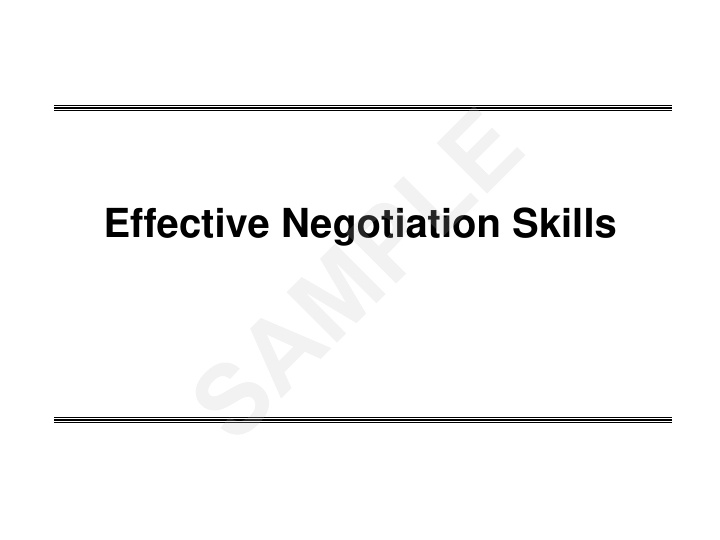



E L Effective Negotiation Skills P M A S
Course objectives • Develop an effective plan for any negotiation E • Recognize interests and positions L • Become more persuasive P • Minimize conflicts and deadlocks M • Neutralize manipulative tactics • Maximize closure opportunities A S
Effective negotiators … E L P Persuade M Prepare Listen A S
Position versus interest E L WHA HAT WHY P versus M A S
To find underlying interests … • Probe. Similar positions may be held E for very different reasons. L P M A S
Understand yourself • “What do I want?” E • “Why do I want L these things?” P • “In what order do I want them?” M A S
Information sources E L P M A S
“Plan B, C, D …” • Identify worst- Goal: A list of E case scenario actions you can L • Create take if no P competition agreement is • Consult experts M reached • Identify your A leverage S
Develop good listening habits • Give your full attention E • Show you’re listening L • Don’t make assumptions P • Don’t jump to conclusions M • Paraphrase to confirm understanding A • Show empathy S
Create a dialog • Be fully engaged E • Remain non- L judgmental and P open • Don’t use corporate M double-speak A S
Nonverbal messages E L P M A S
What to do with what you hear • Respond to your E counterpart’s L arguments P • Put yourself in the other person’s M shoes A • Develop reasonable responses to their S “no”
Recognizing your buttons • What makes you E angry or L frustrated? P • Who rubs you the M wrong way? • When do you stop A listening? S
Choose your response • Accept E – Decide current situation is reality, and L move forward P • Adjust M – Suggest a change to the current situation • Avoid A – Suggest a major time-out S
Strategy steps E L P End M Deflect dirty tactics Concede on unimportant items A Be silent S Acknowledge
Leverage • Types E – Positive L – Negative P – Normative M • Apply subtly A S
“Dirty” tactics E Delay L tactics P Stuck on position M A Anger S
Difficult people E L P Attacker Dominator M A S Passive- Rambler Aggressive
The language of cooperation “People receiving concessions often E feel better about the bargaining process L than people who get a firm, ‘fair’ price.” P M — Richard Shell A Bargaining for Advantage S
Put it in writing • What you are E receiving L • What you are paying for what you are P receiving M • Who the parties involved are A • The duration of the S agreement
Recommend
More recommend